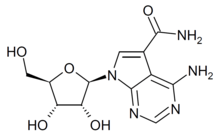Sangivamycin
Sangivamycin is a natural product originally isolated from Streptomyces rimosus, which is a is a nucleoside analogue. It acts as an inhibitor of protein kinase C. It has antibiotic, antiviral and anti-cancer properties and has been investigated for various medical applications, though never approved for clinical use itself, however a number of related derivatives continue to be researched.[1][2][3][4][5][6][7]
 | |
| Identifiers | |
|---|---|
| |
| CAS Number | |
| PubChem CID | |
| ChemSpider | |
| UNII | |
| ChEBI | |
| ChEMBL | |
| ECHA InfoCard | 100.162.068 |
| Chemical and physical data | |
| Formula | C12H15N5O5 |
| Molar mass | 309.28 g·mol−1 |
| 3D model (JSmol) | |
| |
| |
See also
- CMX521 (methylated analogue)
- GS-441524
- NITD008
- Pyrazofurin
References
- Tolman RL, Robins RK, Townsend LB (January 1968). "Pyrrolo[2,3-d]pyrimidine nucleoside antibiotics. Total synthesis and structure of toyocamycin, unamycin B, vengicide, antibiotic E-212, and Sangivamycin (BA-90912)". Journal of the American Chemical Society. 90 (2): 524–6. doi:10.1021/ja01004a076. PMID 5634627.
- De Clercq E, Bernaerts R, Bergstrom DE, Robins MJ, Montgomery JA, Holy A (March 1986). "Antirhinovirus activity of purine nucleoside analogs". Antimicrobial Agents and Chemotherapy. 29 (3): 482–7. doi:10.1128/aac.29.3.482. PMID 3013084.
- Loomis CR, Bell RM (February 1988). "Sangivamycin, a nucleoside analogue, is a potent inhibitor of protein kinase C". The Journal of Biological Chemistry. 263 (4): 1682–92. PMID 3338987.
- Kučić N, Mahmutefendić H, Lučin P (August 2005). "Inhibition of protein kinases C prevents murine cytomegalovirus replication". The Journal of General Virology. 86 (Pt 8): 2153–2161. doi:10.1099/vir.0.80733-0. PMID 16033962.
- Lee SA, Jung M (May 2007). "The nucleoside analog sangivamycin induces apoptotic cell death in breast carcinoma MCF7/adriamycin-resistant cells via protein kinase Cdelta and JNK activation". The Journal of Biological Chemistry. 282 (20): 15271–83. doi:10.1074/jbc.M701362200. PMID 17371872.
- Bastea LI, Hollant LM, Döppler HR, Reid EM, Storz P (November 2019). "Sangivamycin and its derivatives inhibit Haspin-Histone H3-survivin signaling and induce pancreatic cancer cell death". Scientific Reports. 9 (1): 16588. doi:10.1038/s41598-019-53223-0. PMID 31719634.
- Smith HC, et al. Methods of treating and inhibiting ebola virus infection. Patent application CA3040540, Oyagen Inc, 17 May 2018
This article is issued from Wikipedia. The text is licensed under Creative Commons - Attribution - Sharealike. Additional terms may apply for the media files.